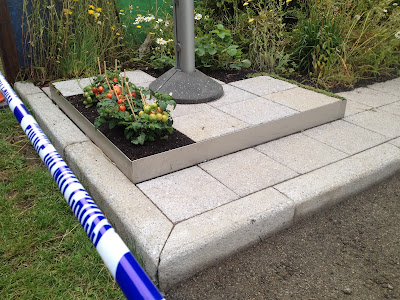"We're born alone, we live alone and we die alone. Only through our love and friendship can we create the illusion for a moment that we're not alone"
- Orson Welles
Our planet is getting smaller.
The ease with which we can visit international friends or family, or make use of a world of incredible ways with which to communicate, can make us at times complacent about the threat of disconnection. Social media has exploded onto the public consciousness, allowing us to honestly claim a network of hundreds, perhaps thousands of friends. Yet loneliness appears to be rising almost as steadily as our proximity to our neighbours shrinks. How is it that as we live closer together we are pulled apart?
 |
| Julian Wild's 'Morpheme' |
A study in 2009 by the BBC looking at life in the UK attempted to create a loneliness index to chart social fragmentation, to see where the highest concentration of people that felt drastically disconnected from their community lived. Data was driven from census information taken in 1971 and 2001, the study then ranked places using a formula based on the proportion of people in an area who are single, those who live alone, the numbers in private rented accommodation and those who have lived there for less than a year. The higher the proportion of people in those categories, the less rooted the community, according to social scientists. They refer to it as the level of "anomie" or the "feeling of not belonging".
Two findings are immediately apparent: The weakest communities in 1971 were significantly stronger than any community thirty years later. Cities appear to create the least cohesive communities.
This trend has caused a reaction in a number of artists to try and use art to both raise awareness of this increasingly modern phenomenon and to provoke a reaction, to use their work to inspire retaliation.
Julian Wild is a new addition to our stable of artists, his work explores this principle of our connection to those around us. His 2009 project "Making a Connection" created vast communal pieces of art using everyday, low cost materials. Hundreds of people came together in venues across the UK to build undirected structures, free flowing and unbounded. 300 metres of plumber's pipe was assembled and then collapsed by an eclectic mix of all sections of society, the creation process as much of the artwork as the piece.
 |
| "Making a Connection", Tabernacle 2009 |
The work creates relationships; between the piece and the space, contributors and artist, rough materials and high aesthetic. Taking something as inexpensive, overlooked and commonplace as plumber's piping and using it to facilitate meaningful art is a concept that I love.
 |
| "Making a Connection", Bankside 2009 |
This theme of interaction between objects continues throughout Julian's work. Small pieces of granular materials are fused together to create a line of work he titled 'Systems'. Conjuring images of machinery and function, this description perfectly captures the industrial feel of modern life that has led to our increasing sense of ennui and disconnection.
 |
| "System 1" |
I love his work, the lines and patterns that make up his pieces turn a wonderfully conceived idea into art that is stunning on an aesthetic basis alone. I find that I can stare at these indefinitely, seeing something new every time as my brain scans for imposed visual meaning, a modern cloud-gazing.
Both Julian and I are interested in taking the industrial and marrying it with the
organic. We are fortunate to represent Julian at our upcoming
sculpture garden (launching in Spring 2013, see website for detail),
placing these pieces in quintessentially British countryside will be a
wonderful juxtaposition.
 |
| "System 3" |
We shall also be running a sister project to the "Making a Connection", creating vast and snaking structures within woodlands, open ground, through collapsed buildings, the opportunity is incredibly exciting and I shall keep you posted. If you would like to get involved then do contact us to be put on the mailing list, collaborating with an artist of Julian's calibre in creating something beautiful on the grounds of a Kentish estate is a rare opportunity, one for which cannot wait.
Thanks for reading and remember, if the theme of loneliness rings true with you then simply remember the words of D.H Lawrence:
"Perhaps only those people who are capable of real togetherness have that look of being alone in the world"
Yours,
Marshall Murray




















































